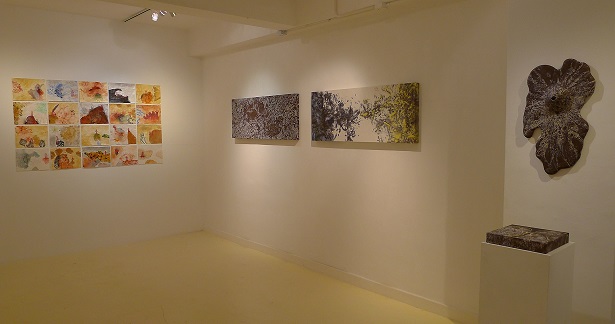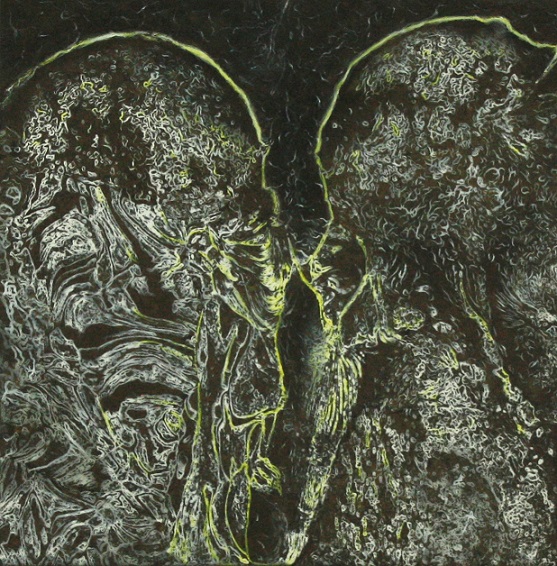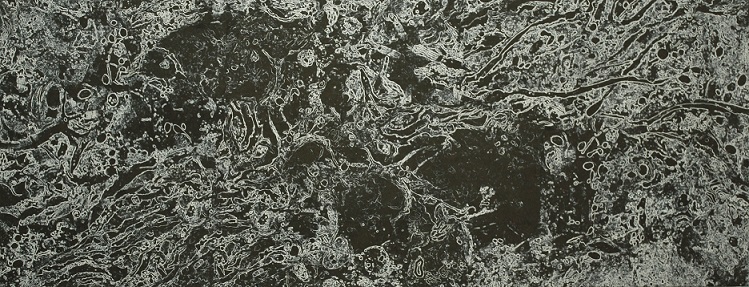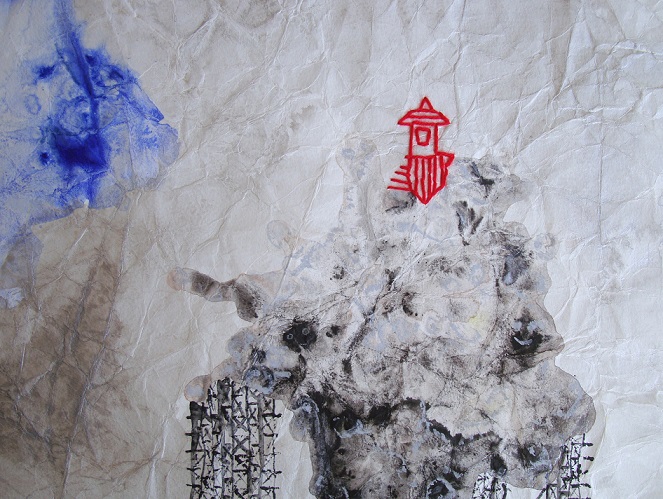Reviews & Articles
Ling Pui Sze & Stephen Eastaugh
John BATTEN
at 6:13pm on 27th November 2014




Captions:
1. An installation view of the exhibition. Stephen Eastaugh's Spiritscapes series (left) and Ling Pui Sze's Reproducibility series (right).
2. & 3. Ling Pui Sze, Reproducibility series, mixed media and ink on paper, 2014 (2 images)
4. Stephen Eastaugh, Spiritscapes series, mixed media on paper, 2013.
All photographs: John Batten and courtesy of artists
(中文翻譯請往下看 Please scroll down to read the Chinese translation.)
As I write, there are continuing street closures and protests against Hong Kong’s government and of the city’s future political reform led by strong-willed (and surprisingly tough) students. Over the last three weeks in the lead-up to this exhibition, Hong Kong has seen satirical banners and art, street lectures and rhetoric, barricades, police and protester lines, tear gas, pepper-spray, and a laid out tent city of improvised living facilities. It has been a heady, vaporous time.
A few days ago, Hong Kong artist Lam Hoi Sin posted, adding to the plethora, a comment on Facebook. She said something along the line that “art, at this time of protests, was irrelevant.” On that very day, exhausted by the tension of further possible violence on Hong Kong’s usually peaceful streets and needing personal refuge, I popped into a nearby gallery to clear my mood.
Art may give and question, but doesn’t answer back, unless requested. Art sits to be seen and the viewer can also just sit. It can be quietly meditative – or, anything you wish it to be. It is rarely irrelevant. Art is there, quietly here, until needed.
In their recent exhibition at China Art Projects, Australian Stephen Eastaugh and Ling Pui Sze of Hong Kong showed a small, aesthetic exhibition: a creative vapour.
Eastaugh’s Spiritscapes depict the charming spirit houses found throughout Asia. Amidst sprawling, celestial mountain landscapes, Eastaugh depicts these spirit houses, the “sturdy intricate golden ones to the crumbling old wooden folk-art houses tucked away in the trunks of ancient trees”, as miniature houses where gifts are offered to ask the spiritual world and its beings for assistance. On highly worked canvas and paper, Eastaugh adds his impressions that embody an animist explanation for our “unknown or complicated world”, into his own abstract landscapes. He, quite rightly, ponders whether the “spirits also exist inside (my) drawings.”
Ling Pui Sze graduated just two years ago from The Chinese University of Hong Kong, and she and her friends still strongly identify with the student life - she has spent countless hours on Hong Kong’s recent protest streets. Her art, however, draws from the natural world. She is personally fascinated by insects and is inspired in her work by life’s building blocks: cells, water and earth. Her Reproducibility series uses layers of ink-jet-printed collage paper and then is further re-worked using Chinese ink. The result is a diaphanous cell-like patterning that resembles life under a microscope – Ling says that these are “new organisms on canvas.” And so they are: alive and vital.
Alive and vital as the streets outside - and, once that vaporous air clears, there may well be a very different Hong Kong landscape.
This was a short essay accompanying the exhibition CC & SE (Ling Pui Sze & Stephen Eastaugh) at China Art Projects, Hong Kong between 20 October to 1 November 2014 (curated by John Batten).
Stephen Eastaugh 和 凌佩詩 @ 香港 中國藝術項目空間 (10/10/2014 – 1/11/2014)
香港學生為了反對非普選政府所提出的未來政治改革方案,正堅定而勇敢地帶領著佔領街道及示威行動。過去三星期內直至這展覽開幕,香港已出現了諷刺意味的橫額和藝術作品、街頭授課及辯論、路障、警察與示威者的列陣、催淚彈、胡椒噴霧,以及在遍地帳幕中的各種生活設施,現在正是鼓動人心迷濛的時期。
日前香港藝術家林愷倩在臉書上其中一個留言提過「在這示威期間,藝術已是毫不相干」。當天,我走在香港如常平靜的街道上,為著將會發生暴力的緊張氣氛而感到疲累並打算休息,於是隨意進入附近一間畫廊,重拾起心情。
藝術可能提出了問題,但無從亦無需得到答案。藝術為著被觀看而擺放著,觀眾也只能坐著觀看。它可以安靜地引發你思考,亦可以成為你想像中的任何事物,它很少是毫不相干的。藝術就在那裡安靜地存在,直至被需要。
這是一個小型的藝術展覽:一種創作的霧氣。
Stephen Eastaugh和凌佩詩除了有年齡差距外,並無共通之處。 Eastaugh是個經驗豐富的藝術家,而凌氏只剛起步。在Eastaugh的藝術生涯中已完成、經歷、展示作品無數次,凌氏在未來的日子和展覽中將會猶豫或悠然地面對她本人以及大眾的視覺呈現。
Eastaugh的《Spiritscapes 》描繪的是亞洲各地令人著迷的靈屋。靈屋是建於延綿山上,「有金色的、堅固而且構造複雜的,亦有藏於古樹樹幹中由民間工藝所製的古老木屋」,微型的小屋是用作奉獻禮物以向天上神靈尋求指引和幫助。Eastaugh的風景畫作結合了他多年來遊歷世界的想像和現實投射。由遙遠的南極洲藝術駐村計劃開始至過去十年, Eastaugh花了大量時間用針線縫合壓皺的紙張或布,縫紉的線和圖像「大大地增加作品的紋理」。在抽象的風景中加上Eastaugh印象中的小屋,呈現著泛靈論者所言之「未知或繁複的世界」,他亦確實思忖著「神靈是否存在於自己的畫作中」。
凌佩詩在兩年前畢業,她和她的朋友仍然與學生活動有相當密切聯繫,亦於最近示威的街道上渡過無數個小時。然而她的創作卻是描繪大自然世界,她個人非常沉迷微小而奇異精緻的昆蟲。在過去十八個月中,她一直鑽研生命構成的元素:細胞,水,土地。在《再現性》系列中,她運用墨水印刷的紙張作拼貼,再用中國墨水在畫面上創作。顯微鏡下的細胞圖像重組成另一種生命再生,凌氏稱他們為「畫布上的新生物」。故此,他們是充滿活力和生機。
正如街道上的活力和生機,當迷濛霧氣散開,香港風景將會完全不一樣。
